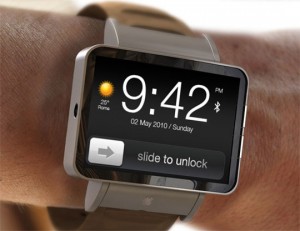What do NASCAR drivers, Little League ball players, and smart watch owners all have in common? They wear advertisements.
Maybe not in quite the same way – but as smart watches start to become popular, ads for smart watches will also start to become commonplace. Wearable ads may not just be targeted at the wearer, and that is something wearable owners will have in common with NASCAR.

Google Glass doesn’t have a display that others can easily read, so any ads that appear on it will likely have to be for the user, but watches are another story. It is pretty common for me to have someone comment on my Omega Ladymatic (I don’t pick the names), and if you assume that a lot of people look, but don’t comment, you can guess that display ads could be a juicy market for watch faces. With multiple companies entering the smart watch market, the way ads are purchased will change, for sure – and while display ads will be one of those changes, there will be also be several others.
1. Contextual Advertising
First, ads are going to be far more contextual. All of that data that we collect from phones is interesting, but a phone has more privacy restrictions than a watch will. This is because people expect more privacy from a phone. You lock your phone, you don’t keep the screen on for everyone to see at all times, and you have things stored on your phone that you think of as private.
Watches have always been reasonably communal in the information you share from them. “Do you have the time?” is something you can ask of a random stranger who is clearly wearing a watch. “Can you take a picture of me for Instagram?” or “Can I call my mom?” is something you would not likely ask a random stranger holding a phone. As a result the ads are going to be creepier in how they follow your location and interests, and likely will not always be on a device.
Related Class: Targeting Millennials on Social & Mobile
Monetizing apps is much more likely to be about agreeing to be advertised to off-device, using data from the device. Think of it like a rewards card: you swipe your card at the grocery store, and then you get ads related to your purchases. The same will be true of data from your wearable. Get an app in exchange for letting Starbucks get access to your geo data, or get free iTunes credits when you opt to allow Bank Of America to know your pulse rate when you are making payments at stores. We are going to trade our info for better targeting, and this will bring changes to the way big companies do their marketing.
2. Multi-Screened Ads
Second, ads are going to be dual screened. Your wearable sharing your data to the cloud on a regular basis will create a way for ads on screens near you to change what they advertise, or how they advertise it. Think about how you might receive an ad when you are stressed compared to when you are relaxed. Or what you would buy when you’re hungry vs. when you are not. As we start wearing things to share our heartbeat and blood sugar levels, it’s not far-fetched to expect ads on your desktop, or even your Hulu, that reflect your current bio-state.
3. Wearable Ad Feedback
Lastly, ads are going to be more emotive. Currently, most ads are relatively bland. This is because advertisers know that you can do as much harm with an ad as good, since it’s far too easy to advertise in a way that rubs a user the wrong way. Wearables are basically electronic mood rings, so for the first time, advertisers will have real time feedback loops about how a user reacted to an ad.
Related Class: Introduction to Retargeting (Remarketing) on Google
When you run an ad that is supposed to make people laugh, the sensors will confirm if you got the desired reaction. If your ad is intended to make users mad, like a political ad that criticizes a candidate for saying something offensive, the wearable can confirm that reaction as well. For example, if a company ran an ad featuring a gay family in a home with conservative values, the feedback would likely tell that company to consider a more mainstream ad. Running the same ad in the home of a progressive “modern family” would bring the company feedback showing how the ad resonates positively, and the company would then know that those types of ads will work in that household in the future.
Wearables will soon be a lot like NASCAR drivers in their advertising ways. And in another sense, NASCAR is all about data. The drivers log their own data, track all sorts of sensors, and wear indicators that follow the pulse of the car and the driver. That data is then used to achieve a successful outcome. In that way, wearables have even more parallels to NASCAR than you might think.
